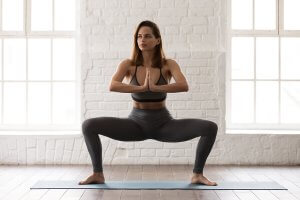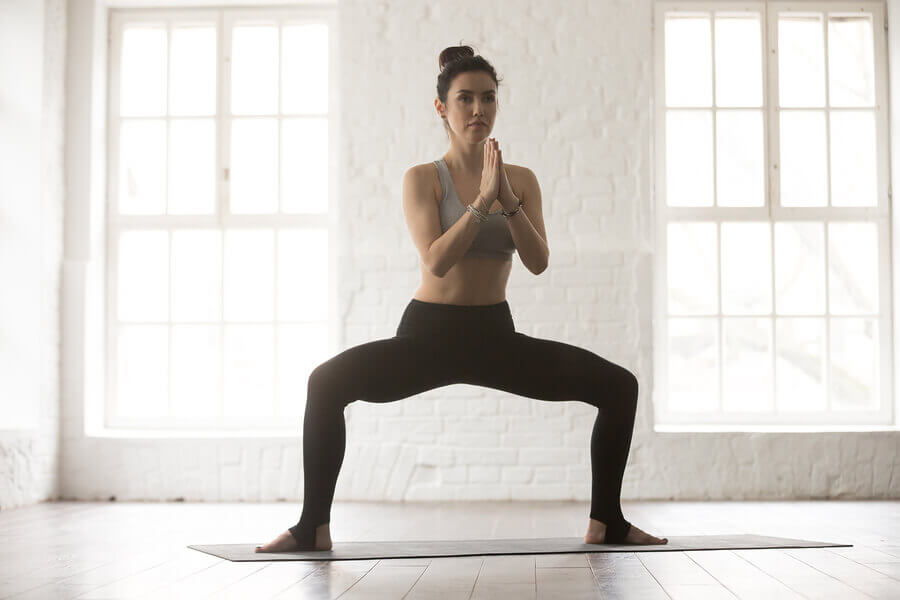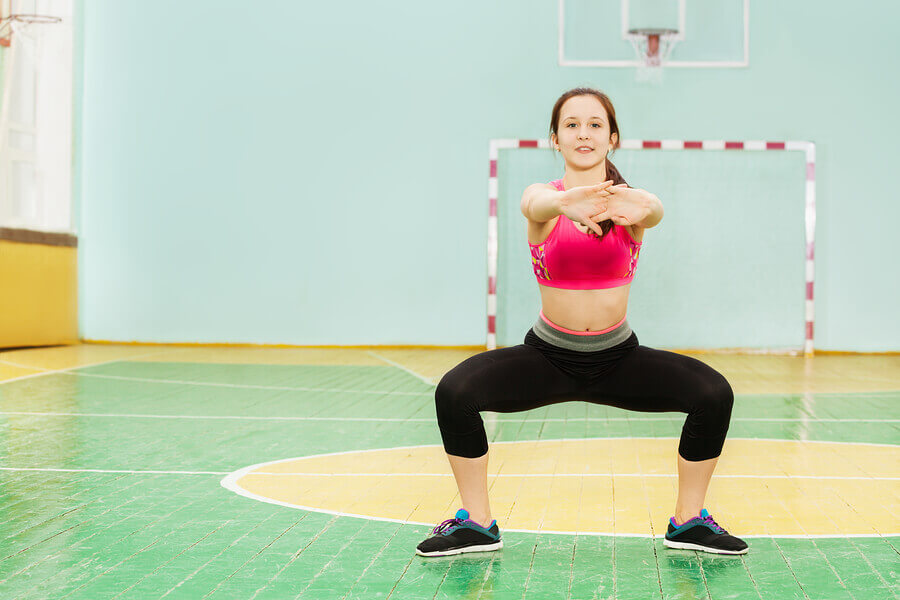Sumo Squat: A Great Way to Strengthen your Adductors

The sumo squat is an amazing variation of the versatile squat to strengthen your adductors. This exercise will also engage the quads, the hamstrings, and the spinal erectors. It also helps you work the gluteal muscles and the lower back muscles, including your abs.
As with any kind of squat, the sumo squat was especially designed to engage your lower body. By strengthening your legs you can improve your balance and coordination, which will improve the rest of your training.
To get all of these benefits, all you have to do is learn how to perform the sumo squat. Then, just add it to your training routine.
An easy exercise?
As with virtually all versions of this type of exercise, at first glance, the sumo squat seems simple and easy. This is true even in the variants in which dumbbells or bars are used to add weight.
However, appearances can be deceiving. Its execution demands not only strength and endurance but also balance and coordination.
Completing the recommended series so that you can see the benefits of this exercise is a matter of constancy and concentration. One of the many benefits that this practice brings is the reduction of the risks of injury when playing sports such as soccer, volleyball or basketball.
However, the erroneous performance of this exercise can actually cause some pretty serious injuries. Therefore, it shouldn’t be taken lightly. Beginners should be supervised by a qualified trainer and pay attention to details.
Sumo squat, step by step
To perform a correct sumo squat, you have to place your feet at double your shoulder width. Of course, this position makes it necessary that your feet face outside at approximately 60 degrees, instead of pointing forward as in the common squat.
At the same time, grasp your hands in front of you and hold them at chest height. Remember to always keep your elbows slightly flexed.

The actual movement of the sumo squat is quite similar to the regular squat. In itself, the squat should feel as if you were about to sit on a chair. As you flex your knees, keep your back straight to avoid any possible injuries.
To do a proper squat, engage your core and tighten your abs. This will allow you to control your body as it moves down and up.
For the sumo squat, place your hips aligned with your knees, keeping these wide open. This is the only way you’ll thighs will enjoy a proper workout. We recommend you do four sets of 10 to 12 repetitions each.
Of course, you can include the sumo squats in your regular training routine. This is an ideal exercise if you’re doing high-intensity interval training. In these cases, the number of repetitions per series tends to be higher, from 30 to 50.
Details that make a difference
We cannot stress this point enough, keeping a proper position throughout the exercise is vital to avoid any kind of injury. The first aspect to bear in mind is to always keep your back straight and not bend forward as you lower your body. If you can’t keep your back straight, then don’t go as far down when bending your knees.
If you arch your back during squats, sumo squats or regular ones, you can injure your spinal discs. This is due to the high pressure applied to your lower back that in turn can lead to extremely painful injuries.
Of course, the only way to keep your back safe is to also pay attention to the position of your feet. The soles of your feet must remain touching the floor at all times during this exercise. Avoid lifting your heels, as it’ll make it difficult to keep your balance. Plus, when you keep your feet firmly rooted, it’s easier to ensure your knees are kept in the right position.

Variations of the sumo squat
The most common variation of the sumo squat is the one that includes a small dumbbell. Generally, for convenience, the kettlebell is the ideal complement for the sumo squat, as it offers the user an easy way to handle it. When using weights, both arms should be kept straight and you should hold the weight down between your legs.
Another variant includes the use of the bar. Of course, you can add weights to the bar, but make sure you don’t add too much or you risk spinal injury. In this exercise, the way in which the feet are placed is more similar to that used in the ‘standard’ squat. Meanwhile, you can hold the bar two different ways:
- The first one is in a low position, on the lateral deltoids.
- The other possibility is known as ‘high bar’ and the support point is the upper trapezius.
In any of its alternatives, sumo squat exercises are a very important help to strengthen the adductors. Add it to your routine and enjoy its benefits!
The sumo squat is an amazing variation of the versatile squat to strengthen your adductors. This exercise will also engage the quads, the hamstrings, and the spinal erectors. It also helps you work the gluteal muscles and the lower back muscles, including your abs.
As with any kind of squat, the sumo squat was especially designed to engage your lower body. By strengthening your legs you can improve your balance and coordination, which will improve the rest of your training.
To get all of these benefits, all you have to do is learn how to perform the sumo squat. Then, just add it to your training routine.
An easy exercise?
As with virtually all versions of this type of exercise, at first glance, the sumo squat seems simple and easy. This is true even in the variants in which dumbbells or bars are used to add weight.
However, appearances can be deceiving. Its execution demands not only strength and endurance but also balance and coordination.
Completing the recommended series so that you can see the benefits of this exercise is a matter of constancy and concentration. One of the many benefits that this practice brings is the reduction of the risks of injury when playing sports such as soccer, volleyball or basketball.
However, the erroneous performance of this exercise can actually cause some pretty serious injuries. Therefore, it shouldn’t be taken lightly. Beginners should be supervised by a qualified trainer and pay attention to details.
Sumo squat, step by step
To perform a correct sumo squat, you have to place your feet at double your shoulder width. Of course, this position makes it necessary that your feet face outside at approximately 60 degrees, instead of pointing forward as in the common squat.
At the same time, grasp your hands in front of you and hold them at chest height. Remember to always keep your elbows slightly flexed.

The actual movement of the sumo squat is quite similar to the regular squat. In itself, the squat should feel as if you were about to sit on a chair. As you flex your knees, keep your back straight to avoid any possible injuries.
To do a proper squat, engage your core and tighten your abs. This will allow you to control your body as it moves down and up.
For the sumo squat, place your hips aligned with your knees, keeping these wide open. This is the only way you’ll thighs will enjoy a proper workout. We recommend you do four sets of 10 to 12 repetitions each.
Of course, you can include the sumo squats in your regular training routine. This is an ideal exercise if you’re doing high-intensity interval training. In these cases, the number of repetitions per series tends to be higher, from 30 to 50.
Details that make a difference
We cannot stress this point enough, keeping a proper position throughout the exercise is vital to avoid any kind of injury. The first aspect to bear in mind is to always keep your back straight and not bend forward as you lower your body. If you can’t keep your back straight, then don’t go as far down when bending your knees.
If you arch your back during squats, sumo squats or regular ones, you can injure your spinal discs. This is due to the high pressure applied to your lower back that in turn can lead to extremely painful injuries.
Of course, the only way to keep your back safe is to also pay attention to the position of your feet. The soles of your feet must remain touching the floor at all times during this exercise. Avoid lifting your heels, as it’ll make it difficult to keep your balance. Plus, when you keep your feet firmly rooted, it’s easier to ensure your knees are kept in the right position.

Variations of the sumo squat
The most common variation of the sumo squat is the one that includes a small dumbbell. Generally, for convenience, the kettlebell is the ideal complement for the sumo squat, as it offers the user an easy way to handle it. When using weights, both arms should be kept straight and you should hold the weight down between your legs.
Another variant includes the use of the bar. Of course, you can add weights to the bar, but make sure you don’t add too much or you risk spinal injury. In this exercise, the way in which the feet are placed is more similar to that used in the ‘standard’ squat. Meanwhile, you can hold the bar two different ways:
- The first one is in a low position, on the lateral deltoids.
- The other possibility is known as ‘high bar’ and the support point is the upper trapezius.
In any of its alternatives, sumo squat exercises are a very important help to strengthen the adductors. Add it to your routine and enjoy its benefits!
All cited sources were thoroughly reviewed by our team to ensure their quality, reliability, currency, and validity. The bibliography of this article was considered reliable and of academic or scientific accuracy.
- Chijani, Nicolás. Análisis biomecánico de las sentadillas. Extraído de: https://g-se.com/uploads/blog_adjuntos/an_lisis_biomec_nico_de_las_sentadillas.pdf
- Rugby Alcorcón. 2016. Rutina de ejercicios. Extraído de: http://rugbyalcorcon.com/wp-content/uploads/2016/03/Ejercicios_Sub14_Sub16_URO_Rugby_Alcorcon.pdf
- Infomed Red de Salud de Cuba. Ejercicios para combatir la celulitis. Extraído de: http://www.sld.cu/galerias/pdf/sitios/rehabilitacion-ejer/ejercicio_para_la_celulitis1.pdf
This text is provided for informational purposes only and does not replace consultation with a professional. If in doubt, consult your specialist.








